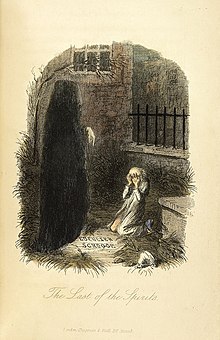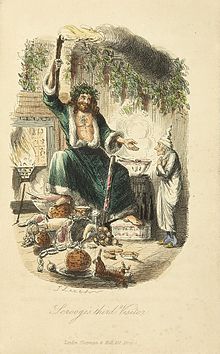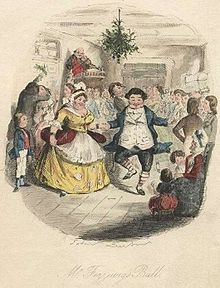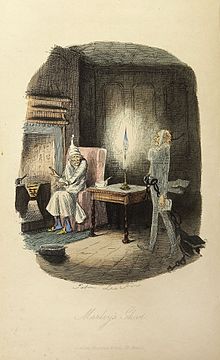A Christmas Carol
This is the sighted version that was marked on March 22, 2021. There are 2 pending changes that still need to be sighted.
![]()
The title of this article is ambiguous. For other meanings, see A Christmas Carol (disambiguation).
A Christmas Carol in Prose, Being a Ghost-Story of Christmas (literally A Christmas Carol in Prose, or A Ghost-Story of Christmas, German usually Eine Weihnachtsgeschichte) is one of Charles Dickens' best-known tales. It was first published on December 19, 1843, with illustrations by John Leech.
The story is about the moneylender Ebenezer Scrooge, a grumpy old miser, who in a single night receives a visit first from his deceased partner Jacob Marley and then from three other spirits, who finally help him to change his life. The book contains strong socially critical overtones, which Dickens intended to use to denounce the ills of 19th-century Britain.

Title page of the first edition of A Christmas Carol, coloured illustration by John Leech
Storyline
A Christmas Carol is divided into five staves.
Verse I: Marley's Ghost
The story begins with the simple statement that Jacob Marley is dead. The reader is informed that Jacob Marley was the business partner, companion, and only friend of the protagonist Ebenezer Scrooge until he died seven years ago on Christmas Eve. Dickens describes Ebenezer Scrooge as a person who is full of coldness and spreads coldness everywhere, as enormously stingy and greedy. After Marley's death, Scrooge is the sole owner of the department store "Scrooge and Marley" and employs one clerk, Bob Cratchit.
As he does every year, Scrooge's nephew Fred visits his uncle to invite him to Christmas dinner and wish him "Merry Christmas!". Scrooge completely rejects both the invitation and the good wishes, and even Christmas itself - angrily retorting to his nephew, "Pah! Stupid stuff!" (English "Humbug!"), which can be seen as a phrase typical of Scrooge. That same evening, Scrooge is visited by two "handsome gentlemen" who ask for donations for the poor. Scrooge is not moved, he asks rhetorically if there are no prisons and workhouses and if there are not already laws to help the poor. Of course there are, so Scrooge is sure that by paying his taxes he has more than fulfilled his duty.
In the evening, Scrooge goes home; when he goes to open the door, he briefly sees the face of his deceased friend Marley on the door knocker, but does not want to believe it and enters the house. There, everything seems normal until Marley's ghost appears to him. The ghost is chain-hung, with paraphernalia of business hanging from his chain: cash boxes, wallets, and the like. Marley's ghost explains that he has forged this chain for himself in the course of his life. Because he was not among people throughout his life, but had only given himself over to his greed for money, he must now, after his death, go among people as a ghost; the chain acts as a symbol for this. The Ghost points out to Scrooge that Scrooge himself also has such a chain; both chains were of the same length seven years ago, but now Scrooge's chain has grown a good deal longer. The ghost leaves the troubled Scrooge saying that three more ghosts would visit him to save Scrooge. The first stanza closes with Scrooge going to bed.
Verse II: The first spirit
After Scrooge wakes up in the middle of the night, the first of the three ghosts appears to him. Dickens describes him as a comical figure, both child and old man. In a soft voice, he introduces himself as the "Ghost of Christmas Past." The ghost takes Scrooge through his past, starting with little Scrooge, who had no friends even in his childhood and sat in school at Christmas, disowned by his family, to read children's books. Scrooge shows himself touched by the scenes of his childhood.
The further journey through Scrooge's Christmas past shows Scrooge as a young man who learned his later profession from Mr. Fezziwig, a department store owner. Scrooge and the Ghost attend a company Christmas party, which makes Scrooge realize how little (financial) effort can make people very happy.
Another stop on the journey is Scrooge in his prime, when he literally traded his great love for the love of money. Scrooge appears shaken in the presence of the Ghost, wanting to see nothing more of the past, only to go back home. Nevertheless, the Ghost shows him another scene: his former fiancée in an idyllic Christmas scene with children and husband. Scrooge is broken, begging to be allowed to return home. Scrooge gets back home and is dead tired.
Verse III: The Second Spirit
Now the second of the three ghosts visits Scrooge. He calls himself "Ghost of this year's Christmas Night". He makes it clear that there have already been over 1800 of his kind - meaning that there has been a new "Christmas Ghost" every year since the birth of Christ. This year's "Ghost of Christmas Night" also takes Scrooge on a tour of the streets of London, where they experience the Christmas atmosphere and finally stop in front of a bakery shop. There, the ghost shows Scrooge that with a few splashes of special water, he can end an argument and make food taste Christmassy. This should explain why everything tastes so special to us at Christmas and there is a lot of harmony with little quarreling.
It is on this journey with the Ghost of Christmas Now that he gets to know clerk Robert "Bob" Cratchit and his family better. Scrooge's clerk and his wife have several children, with one child in particular being highlighted: Crippled Tim Cratchit is very small, can only get around with a frame due to his disability, and it appears that he would soon die due to malnutrition and poor (medical) care. This is where a real change in Scrooge's character becomes apparent: he asks the ghost if Tintin has a while to live - but the ghost has doubts. Scrooge shows compassion, whereupon the Ghost reminds him of his own words in the past: Scrooge had said that Tintin would probably be better off dying to reduce overpopulation. The Cratchits have a nice Christmas despite their poverty, and Bob Cratchit even toasts his employer - it is Christmas, after all.
With the ghost, Scrooge experiences another Christmas scene, this time at his nephew Fred's house, where he has fun socializing and telling stories about the stubborn Scrooge, making fun of the expression "Stupid stuff!". After dinner, Fred and company then play games, including the following: Someone thinks up a term that the others must guess - queries may only be answered yes or no. The something is, according to the answers a living animal, which one sees on London's streets, nobody would eat, which sometimes grunts and grumbles - meant is of course "Uncle Scrooge", a royal amusement for Fred and the others.
The third stanza ends most symbolically. The ghost leaves Scrooge with two children, whom he has kept hidden under his cloak until then. The names of the two already point in a certain direction, they are called "Ignorance" and "Lack". Upon Scrooge's inquiry, the Ghost explains that they are not his own, but children of mankind. Scrooge resists taking in the children. He asks if they have no place to stay; the Ghost again responds with a counter-question, again representing Scrooge's own words, "Are there no prisons, workhouses?"
Verse IV: The Last Spirit
The last of the three ghosts appears to Scrooge without saying a single word. The conclusion that it is the "Ghost of Christmas Yet to Come" is left to Scrooge. The ghost leads Scrooge through the streets of London again. The two listen to a conversation between a group of businessmen. The men are talking about the death of an unnamed person who had apparently amassed some money, but whom no one liked. Another conversation Scrooge and the ghost are able to overhear: Again, it is about the "old scrooge" who had died. It has long been clear to the reader that this can only be about the deceased Scrooge - but he himself is either clueless or simply refuses to believe it. He hopes to see a scene in the future with the ghost, in which he himself appears and, now converted to a good man, brings about something good.
Instead, the ghost leads him to a gritty part of town, specifically a poor neighborhood, and in that neighborhood, a store whose owner buys up any goods. A number of people have shown up at "old Joe's," and it quickly becomes clear that they want to sell him goods they stole from the mysterious dead man's house. Not one of the people present shows any guilt, even when a woman sells the bed curtains and shroud she had stolen from the corpse lying on the bed. It is made abundantly clear to the reader how unpopular the dead man must have been. Scrooge shows the first approach of realization in the next moment, when he stands in the death chamber with the ghost and is asked to look under the shroud-which he refuses to do and, in the end, does not do. Scrooge begs the Ghost to show him someone who is showing emotion about the dead man. All he sees in response is a couple worried about a loan not yet repaid to the dead man and relieved by the death of their creditor. Not wanting to see this, of course, Scrooge asks the Ghost to show him sadness caused by a death; but the scene that follows is also meant to upset him more than reassure him: Scrooge and the Ghost visit the Cratchit family, who are mourning the death of Tiny Tim.
At the end of the chapter, all ambiguities are cleared away. At Scrooge's request to know who the dead man is, the Ghost of the Future shows him a tombstone. In horror, Scrooge reads the inscription: Ebenezer Scrooge. Before Scrooge's eyes, who is close to collapse, the ghost disappears into a bedpost. In fact, in Scrooge's own bedpost.
Verse V: The End
Completely transformed and full of good intentions, Scrooge is back in the real world: without ghosts and alive and kicking. Scrooge even manages to laugh, and one event for him is to ask a boy what day it is - he replies that it is Christmas Day - and Scrooge realizes that everything past must have happened on that one last night. He also instructs the boy to buy a turkey twice the size of Tiny Tim and give it to the Cratchit family. The transformed Scrooge's next actions are first to apologize to one of the "stately gentlemen" (see stanza I), to whom he makes a generous donation, and finally Scrooge does accept his nephew's invitation to celebrate with him and friends on Christmas Day-and both Fred and all of his friends are delighted to have Scrooge there. The next day, Scrooge is at his counting house very early; his stated purpose: to catch his clerk being late. Scrooge, of course, is only joking - after he has given Bob Cratchit a rough time, he says, "Merry Christmas, Bob!" and raises his salary.
In the summary last paragraph, the narrator once again emphasizes Scrooge's change in personality, "Scrooge was better than his word," Tiny Tim would survive, and finally, "God bless each of us."

Ebenezer Scrooge and Robert "Bob" Cratchit

The last ghost

The first ghost

The second ghost

Mr. Fezziwig's ball

Marley's ghost
Filming
Cinema
The book has been adapted numerous times into movies and series. Particularly well known are:
- 1901: Scrooge, or Marley's Ghost, the first known film adaptation as a British short.
- 1908: A Christmas Carol, US short film starring Tom Ricketts.
- 1935: Scrooge, first sound film, with Seymour Hicks (Scrooge), Donald Calthrop, Robert Cochran, directed by Henry Edwards
- 1938: A Christmas Carol, first US film adaptation by MGM with Reginald Owen as Scrooge
- 1951: A Christmas Story (Scrooge), British film version with Alastair Sim as Ebenezer Scrooge
- 1954: A Christmas Carol with Fredric March as Ebenezer Scrooge, directed by Ralph Levy
- 1955: A Christmas Carol in Prose with Harald Mannl as Ebenezer, director: Wilm ten Haaf
- 1970: Scrooge, musical starring Albert Finney, who won the Golden Globe Award in the category Best Leading Actor - Comedy or Musical for his performance, directed by Ronald Neames
- 1984: Charles Dickens' A Christmas Carol, with George C. Scott as Ebenezer Scrooge
- 1988: The Ghosts I Called ... (Scrooged), with Bill Murray as Frank Cross (a modern incarnation of Ebenezer Scrooge).
- 1999: A Christmas Carol - The Night Before Christmas (Original title: A Christmas Carol/Alternative German title: A Christmas Carol - Die drei Weihnachtsgeister), with Patrick Stewart in the role of Ebenezer Scrooge
- 2000: A Diva's Christmas Carol - A Very Special Christmas, with Vanessa Lynn Williams in the role of Ebony Scrooge
- 2001: A Christmas Fairy Tale (Christmas Carol: The Movie)
- 2003: Carol and the Christmas Spirits (A Carol Christmas), with Tori Spelling, Gary Coleman and William Shatner.
- 2004: A Christmas Carol - The Musical, a musical version with Kelsey Grammer.
- 2009: Disney's A Christmas Carol, directed by Robert Zemeckis and starring Jim Carrey as Ebenezer Scrooge and Gary Oldman as Bob Cratchit and Jacob Marley.
Television productions
- 1949: The Christmas Carol, US television movie special by William Keighley in black and white
- 1960: A Christmas Carol in Prose or A Ghost Story for Christmas, German television play with Carl Wery as Ebenezer Scrooge, director: Franz Josef Wild
- 1997: Ms. Scrooge - A Wonderful Angel, US-American-Canadian television movie with Cicely Tyson in the leading role Ebenita Scrooge, director: John Korty
- 2019: A Christmas Carol, BBC miniseries
Other variations
- 1971: A Christmas Carol, animated film, which won an Oscar in 1973 in the categoryBest Animated Short Film, directed by Richard Williams
- 1983: Mickey's Christmas Carol, animated short film depicting the well-known story with Disney characters, such as Scrooge impersonating Scrooge, Mickey Mouse impersonating Bob Cratchit, and the ghosts being played by Goofy, Jiminy Cricket and Puss Karlo.
- 1992: The Muppet Christmas Carol, with Michael Caine as Ebenezer Scrooge, almost all the other characters are played by Muppets (like Gonzo as Charles Dickens, Kermit the Frog as Bob Cratchit and Miss Piggy as Emily Cratchit)
- 1994: Fred's Christmas Show (A Flintstones Christmas Carol)
- 1997: A Christmas Carol, animated cartoon, directed by Stan Phillips
- 2001: A Christmas Carol Musical on Broadway (starring Nick Jonas of the Jonas Brothers as Scrooge at age eight)
- 2006: A Sesame Street Christmas Carol, a direct-to-video of Sesame Street
- 2008: Barbie in: A Christmas Story, computer animated film by Rainmaker Entertainment ~100 min long.
- 2017: Charles Dickens: The Man who invented Christmas, looks at how the book came to be.
- 2018: Ghosts of Christmas, feature film of the Augsburger Puppenkiste
Parodic film adaptations
- 1988: Blackadder's Christmas Carol, a Christmas special of the historical sitcom Blackadder, in which Rowan Atkinson takes on the role of Ebenezer Blackadder, who, unlike the original story, is transformed from a compassionate humanitarian to a conniving, selfish egotist by a visit from a ghost (Robbie Coltrane).
- 2008: Big Fat Important Movie (An American Carol), a comedy based on the Christmas story, which is not about Christmas, but about the American Independence Day (4th of July). Kevin Farley plays the role of Michael Malone (based on Ebenezer Scrooge, as a parody of Michael Moore), who is converted from a USA-hater to a patriot.
- 2009: The Womanizer - The Night of Ex-Girlfriends (Ghosts of Girlfriends Past)
- 2010: Feast of Love (A Christmas Carol) was the 2010 Christmas special of the British science fiction series Doctor Who, in which the Doctor takes on the role of the Ghosts of Christmas and Michael Gambon takes on the role of Scrooge-like Karzan Sardick, giving the story a science fiction twist.
Questions and Answers
Q: Who wrote A Christmas Carol?
A: A Christmas Carol was written by Charles Dickens.
Q: When was A Christmas Carol first published?
A: A Christmas Carol was first published on 19 December 1843.
Q: Who drew the illustrations for A Christmas Carol?
A: The illustrations for A Christmas Carol were drawn by John Leech.
Q: Why did Dickens not make the money he expected on A Christmas Carol?
A: Dickens did not make the money he expected on A Christmas Carol due to the book's high production costs.
Q: What was the state of Christmas customs in Britain when A Christmas Carol was written?
A: When A Christmas Carol was written, the British were longing for the traditional merry Olde English Christmas. Christmas customs of the past were being revived, and new customs such as the Christmas tree and the greeting card were making their first appearances. Old carols were being sung.
Q: Who is the main character of A Christmas Carol?
A: The main character of A Christmas Carol is a Christmas-hating miser named Ebenezer Scrooge.
Q: What is the message of A Christmas Carol?
A: A Christmas Carol has a strong moral message about greed and poverty, and it is usually read at Christmas time.
Search within the encyclopedia